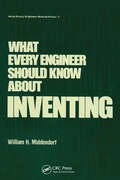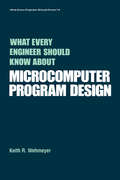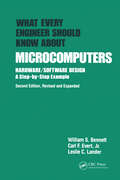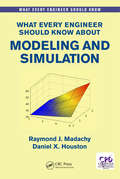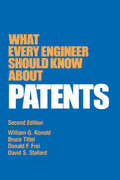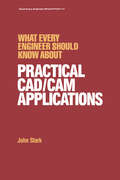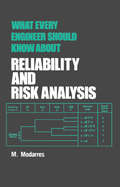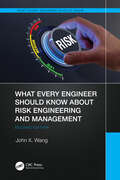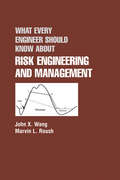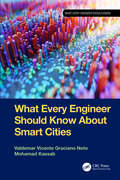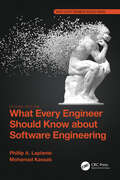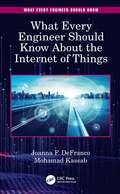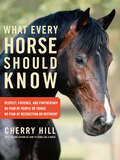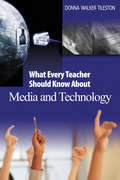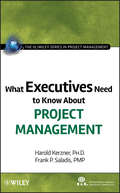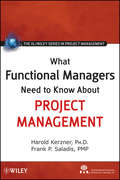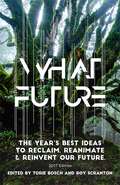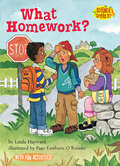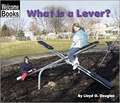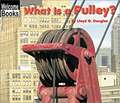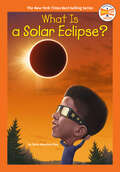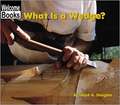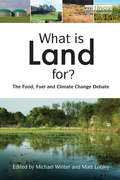- Table View
- List View
What Every Engineer Should Know about Inventing
by William H. MiddendorfThis book provides the reader with the information they need to develop into a person who seeks creative opportunities and responds with elegant inventions. It is intended for young inventor and to all those who have the talent and the desire to invent.
What Every Engineer Should Know about Microcomputer Software
by Keith A. WehmeyerThis book covers the entire scope of computer programming and Structured Program Design, from problem identification to maintaining existing programs. It is intended for two audiences: beginning programmers and experienced programmers seeking ways to improve the quality of their software.
What Every Engineer Should Know about Microcomputers: Hardware/Software Design: a Step-by-step Example, Second Edition,
by William S. Bennett Carl F. Evert Jr. Leslie C. LanderRevised and expanded guide demonstrates microcomputer usage by working through one simple design challenge and explaining its solution. This edition features the contributions of an Ada expert, demonstrates (in 14 new chapters) the development of a microcomputer system structured by this language.
What Every Engineer Should Know About Modeling and Simulation (What Every Engineer Should Know)
by Raymond J. Madachy Daniel HoustonThis practical book presents fundamental concepts and issues in computer modeling and simulation (M&S) in a simple and practical way for engineers, scientists, and managers who wish to apply simulation successfully to their real-world problems. It offers a concise approach to the coverage of generic (tool-independent) M&S concepts and enables engineering practitioners to easily learn, evaluate, and apply various available simulation concepts. Worked out examples are included to illustrate the concepts and an example modeling application is continued throughout the chapters to demonstrate the techniques. The book discusses modeling purposes, scoping a model, levels of modeling abstraction, the benefits and cost of including randomness, types of simulation, and statistical techniques. It also includes a chapter on modeling and simulation projects and how to conduct them for customer and engineer benefit and covers the stages of a modeling and simulation study, including process and system investigation, data collection, modeling scoping and production, model verification and validation, experimentation, and analysis of results.
What Every Engineer Should Know about Patents
by William G. Konold"This useful, authoritative volume focuses on all aspects of intellectual property law with particular emphasis on patent laws enabling the reader to avoid such pitfalls as a loss of rights, and establish valid rights in inventions, trademarks, and writings. "
What Every Engineer Should Know about Practical Cad/cam Applications
by John StarkThis book presents basic information on CAD/CAM and describes how to select, implement, and run a CAD/CAM system in the mechanical engineering environment. It also describes the overall state of CAD/CAM today in different industrial sectors and for different manufacturing technologies.
What Every Engineer Should Know about Reliability and Risk Analysis (What Every Engineer Should Know #30)
by Mohammad Modarres"Examining reliability, availability, and risk analysis and reviewing in probability and statistics essential to understanding reliability methods, this outstanding volume describes day-to-day techniques used by practicing engineers -- discussing important reliability aspects of both components and complex systems. "
What Every Engineer Should Know About Risk Engineering and Management (ISSN)
by John X. WangCompletely updated, this new edition uniquely explains how to assess and handle technical risk, schedule risk, and cost risk efficiently and effectively for complex systems that include Artificial Intelligence, Machine Learning, and Deep Learning. It enables engineering professionals to anticipate failures and highlight opportunities to turn failure into success through the systematic application of Risk Engineering. What Every Engineer Should Know About Risk Engineering and Management, Second Edition discusses Risk Engineering and how to deal with System Complexity and Engineering Dynamics, as it highlights how AI can present new and unique ways that failures can take place. The new edition extends the term "Risk Engineering" introduced by the first edition, to Complex Systems in the new edition. The book also relates Decision Tree which was explored in the first edition to Fault Diagnosis in the new edition and introduces new chapters on System Complexity, AI, and Causal Risk Assessment along with other chapter updates to make the book current. Features Discusses Risk Engineering and how to deal with System Complexity and Engineering Dynamics Highlights how AI can present new and unique ways of failure that need to be addressed Extends the term "Risk Engineering" introduced by the first edition to Complex Systems in this new edition Relates Decision Tree which was explored in the first edition to Fault Diagnosis in the new edition Includes new chapters on System Complexity, AI, and Causal Risk Assessment along with other chapters being updated to make the book more current The audience is the beginner with no background in Risk Engineering and can be used by new practitioners, undergraduates, and first-year graduate students.
What Every Engineer Should Know About Risk Engineering and Management (ISSN #Vol. 36)
by John X. Wang Marvin L. Roush"Explains how to assess and handle technical risk, schedule risk, and cost risk efficiently and effectively--enabling engineering professionals to anticipate failures regardless of system complexity--highlighting opportunities to turn failure into success."
What Every Engineer Should Know About Smart Cities (What Every Engineer Should Know)
by Valdemar Vicente Neto Mohamad KassabGet ready to be at the forefront of the future of urban development! As cities continue to rapidly grow, the demand for sustainable and efficient infrastructure becomes more urgent. That’s where What Every Engineer Should Know About Smart Cities comes in, offering a comprehensive guide to the concepts and technologies driving the transformation of our cities. Delve into the world of smart cities and discover how information and communication technologies are revolutionizing urban environments. With clear definitions and a focus on real-world applications, this book explores the benefits and challenges of smart cities. It also highlights interdisciplinary topics such as smart buildings, autonomous cars, and urban emergency management systems. This book is not just a theoretical exploration of smart cities. It goes beyond that by providing an in-depth look at the key technologies that are essential to creating smart cities. From the Internet of Things and blockchain to digital twins and modeling and simulations, readers will gain a solid understanding of the foundational technologies that make smart cities possible. With detailed discussions and real-world examples of smart mobility, smart health, smart education, and smart agribusiness, readers will gain a deep understanding of the requirements and characteristics that engineers need to contribute to the development of smart cities. Whether you’re an engineer looking to expand your knowledge, a city planner seeking to understand the latest trends, or simply someone interested in the future of urban living, What Every Engineer Should Know About Smart Cities is the ultimate guide to unlocking the potential of smart cities for sustainable urban development and improved quality of life.
What Every Engineer Should Know about Software Engineering (What Every Engineer Should Know)
by Phillip A. Laplante Mohamad KassabThis book offers a practical approach to understanding, designing, and building sound software based on solid principles. Using a unique Q&A format, this book addresses the issues that engineers need to understand in order to successfully work with software engineers, develop specifications for quality software, and learn the basics of the most common programming languages, development approaches, and paradigms. The new edition is thoroughly updated to improve the pedagogical flow and emphasize new software engineering processes, practices, and tools that have emerged in every software engineering area. Features: Defines concepts and processes of software and software development, such as agile processes, requirements engineering, and software architecture, design, and construction. Uncovers and answers various misconceptions about the software development process and presents an up-to-date reflection on the state of practice in the industry. Details how non-software engineers can better communicate their needs to software engineers and more effectively participate in design and testing to ultimately lower software development and maintenance costs. Helps answer the question: How can I better leverage embedded software in my design? Adds new chapters and sections on software architecture, software engineering and systems, and software engineering and disruptive technologies, as well as information on cybersecurity. Features new appendices that describe a sample automation system, covering software requirements, architecture, and design. This book is aimed at a wide range of engineers across many disciplines who work with software.
What Every Engineer Should Know About the Internet of Things (What Every Engineer Should Know)
by Joanna F. DeFranco Mohamad KassabInternet of Things (IoT) products and cyber-physical systems (CPS) are being utilized in almost every discipline and there continues to be significant increases in spending on design, development, and deployment of IoT applications and analytics within every domain, from our homes, schools, government, and industry. This practical text provides an introduction to IoT that can be understood by every engineering discipline and discusses detailed applications of IoT. Developed to help engineers navigate this increasingly important and cross-disciplinary topic, this work: Offers research-based examples and case studies to facilitate the understanding of each IoT primitive Highlights IoT’s connection to blockchain Provides and understanding of benefits and challenges of IoT and its importance to a variety of engineering disciplines Written to be accessible to non-experts in the subject, What Every Engineer Should Know About the Internet of Things communicates the importance of this technology and how it can support and challenge all interrelated actors as well as all involved assets across many domains.
What Every Horse Should Know: A Training Guide to Developing a Confident and Safe Horse
by Cherry HillTrain your horse to embrace a life around humans. Focusing on developing the skills vital for every domesticated horse, this guide stresses the importance of creating an atmosphere where both trainer and horse can overcome fear and cultivate mutual respect. With a series of tests to gauge your horse’s knowledge and training exercises to enrich and strengthen your horse’s comfort around people, you can increase attentiveness, boost confidence, and help your horse reach his full potential.
What Every Teacher Should Know About Media and Technology
by Donna E. TilestonTechnology plus classroom can equal success for students. This invaluable resource for teachers presents classroom applications of media, technology, and the Internet.
What Executives Need to Know About Project Management
by International Institute for Learning Frank P. Saladis Harold R. KerznerDiscover how executives can apply the Kerzner Approach® to improve project managementAs an executive today, you need to become more involved in project management. That doesn't mean you need to become a project manager, but rather you need to know how to set the stage for a project's success, oversee its execution, and intervene directly at key strategic moments. Here's the book that gives you everything you need to know about your role in project management clearly and succinctly.Based on principles set forth in the bestselling Project Management: A Systems Approach to Planning, Scheduling, and Controlling, Tenth Edition, this easy-to-follow guide focuses on the pivotal role you play as an executive in project management. It introduces the acclaimed Kerzner Approach®, demonstrating how it empowers you with the skills needed to ensure that projects are completed successfully, on time, and on budget.The International Institute for Learning/Wiley Series in Project Management features the most innovative, tested-and-proven approaches to project management, all explained in clear, straightforward language. The series offers new perspectives on solving tough project management problems as well as practical tools for getting the job done. Each book in the series is drawn from the related IIL course and is written by noted project management experts.
What Functional Managers Need to Know About Project Management
by Frank P. Saladis Harold R. Kerzner International Institute for LearningDiscover how functional managers can apply the Kerzner Approach to project managementAs a functional manager today, you need to become more involved in project management. That doesn't mean you need to become a project manager, but rather you need to know how to perform specific project-related tasks, work with project team members, understand each other's priorities and problems, and resolve issues jointly. Now here's the book that gives you everything you need to know about your role in project management clearly and succinctly.Based on principles set forth in the bestselling Project Management: A Systems Approach to Planning, Scheduling, and Controlling, Tenth Edition, this easy-to-follow guide focuses on the pivotal role you play as an executive in project management. It introduces the acclaimed Kerzner Approach, demonstrating how it empowers functional managers with the skills needed to ensure that projects are completed successfully, on time, and on budget.The International Institute for Learning/Wiley Series in Project Management features the most innovative, tested-and-proven approaches to project management, all explained in clear, straightforward language. The series offers new perspectives on solving tough project management problems as well as practical tools for getting the job done. Each book in the series is drawn from the related IIL course and is written by noted project management experts.
What Future: The Years Best Ideas To Reclaim, Reanimate & Rreinvent Our Future
by Torie Bosch Roy ScrantonAn anthology of writing that looks at the interplay between technology and our environment to imagine the future and feature the innovators creating the future.
What Happens to Our Trash? (Let's-Read-and-Find-Out Science 2)
by D. J. WardRead and find out about how we can reduce, reuse, and recycle in this colorfully illustrated nonfiction picture book."Perfect for classes just beginning to study environmental concerns," wrote School Library Journal. "Engaging prose and upbeat, gently humorous illustrations introduce the importance of proper trash disposal and recycling."This is a clear and appealing science book for early elementary age kids, both at home and in the classroom. In clear language and art, including diagrams, the book takes readers through such details as how much trash each person creates every day (on average), where the trash goes, and ways kids can make a difference. It concludes with instructions on how to create a compost pileWhat Happens to Our Trash is a Level 2 Let's-Read-and-Find-Out, which means the book explores more challenging concepts for children in the primary grades. The 100+ titles in this leading nonfiction series are:hands-on and visualacclaimed and trustedgreat for classroomsTop 10 reasons to love LRFOs:Entertain and educate at the same timeHave appealing, child-centered topicsDevelopmentally appropriate for emerging readersFocused; answering questions instead of using survey approachEmploy engaging picture book quality illustrationsUse simple charts and graphics to improve visual literacy skillsFeature hands-on activities to engage young scientistsMeet national science education standardsWritten/illustrated by award-winning authors/illustrators & vetted by an expert in the fieldOver 130 titles in print, meeting a wide range of kids' scientific interestsBooks in this series support the Common Core Learning Standards, Next Generation Science Standards, and the Science, Technology, Engineering, and Math (STEM) standards. Let's-Read-and-Find-Out is the winner of the American Association for the Advancement of Science/Subaru Science Books & Films Prize for Outstanding Science Series.
What Homework? (Science Solves It!)
by Linda HaywardAndy forgot to do his homework. He only has a few minutes to find out what he needs to complete the project.
What Is a Lever (Welcome)
by Lloyd G DouglasIllustrations and text describe different examples of the use of simple machines known as levers.
What Is a Pulley (Welcome)
by Lloyd G. DouglasIntroduces pulleys and how they work to raise flags, as well as heavy objects.
What Is a Solar Eclipse? (Who HQ Now)
by Dana Meachen Rau Who HQLearn about the phenomenon of a solar eclipse just in time for the Great American Eclipse that will take place on April 8, 2024 in this title in the Who HQ Now series featuring newsmakers and trending topics.Just in time for the third North American total solar eclipse of the twenty-first century, this book explains how to safely observe solar eclipses, how long eclipses last, and why they result in a blackout period during the day. Young armchair astronomers and astronauts will be inspired by the wonders of outer space and what exists beyond our atmosphere as they learn more about the moon, the sun, and our earth. What really happens during a solar eclipse and how does it affect the energy in our atmosphere? You'll find the most up-to-date eclipse information in this exciting new book.
What Is a Wedge: Simple Machines (Welcome Books)
by Lloyd G. DouglasDifferent types of wedges are explained in a simple manner.
What is Land For?: "The Food, Fuel and Climate Change Debate"
by Matt Lobley Michael WinterIn recent decades agricultural commodity surpluses in the developed world have contributed to a mantra of 'land surplus' in which set-aside, extensification, alternative land uses and 'wilding' have been key terms in debates over land. Quite suddenly all this has changed as a consequence of rapidly shifting commodity markets. Prices for cereals, oil seeds and other globally traded commodities have risen sharply. A contributor to this has been the shift to bioenergy cropping, fuelled by concerns over post-peak oil and climate change. Agricultural supply chain interests have embraced the 'new environmentalism' of climate change with enthusiasm, proudly proclaiming the readiness of the industry to produce both food and energy crops, and to do so with a neo-liberal confidence in markets to determine the balance between food and non-food crops in land use. But policy and politics have not necessarily caught up with these market and industry-led changes and some environmentalists are beginning to challenge the assumptions of the new 'productivism'. Is it necessarily the case, they ask, that agriculture's best contribution to tackling climate change is to grow bioenergy crops or invest in anaerobic-digesters or make land over for windfarms? Might not there be an equally important role in maximising the carbon sequestration or water-holding properties of biodiverse land? What is Land For? tackles these key cutting-edge issues of this new debate by setting out a baseline of evidence and ideas.
What Is Matter Made of?: Science Techbook, Grade 5, Unit 1
by Inc. Discovery EducationNIMAC-sourced textbook
